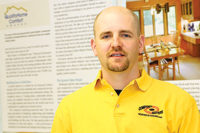
From left to right, Lisa Reed, Joe Hill, and Don Wagner work together as Carney’s sales team. Reed takes the lead calls and performs preliminary research for potential geothermal customers; Hill and Wagner perform detailed analysis and load calcs to determine if homes are good candidates for geothermal system installations.
According to owner Kevin Carney, one of the founder’s sons, the company has never attempted to be the low bidder. Instead, Carney has focused on offering customers the best equipment and service with unsurpassed value and attention to detail. This philosophy has stood them in good stead since they took the plunge into geothermal heating and air conditioning a year and a half ago.
Carney’s sales team, which consists of coordinator Lisa Reed and comfort specialists Don Wagner and Joe Hill, joked that at the time, their boss Kevin was “nervous” while they were merely “cautious.”
Kevin Carney admitted, “For the first geothermal system installation, we spent a lot of time making sure we thought of everything.” But despite the nerves, the project was a resounding success, and the homeowner was thrilled with the work. “He’s done everything but come in and hug and kiss us,” Wagner said.
Now Carney is converting more homeowners in its service area to geothermal energy, and along the way the team has learned some important lessons about effective sales and quality installation practices.
TUNED INTO LOCAL NEEDS
Carney is very attentive to its customers and tries to stay abreast of local concerns. The majority of the company’s work is residential heating and cooling system replacement in Bucks and Montgomery Counties, which are located in an affluent area of southeastern Pennsylvania. According to Kevin Carney, “There’s a lot of people [in our area] that the recession hasn’t affected. For the most part, we’re fortunate to be in an area that hasn’t been hit as hard.”This strong base of higher-end customers is fueling Carney’s expansion into geothermal. And the locals say that the region is more stable than other areas of the country, so neither the booms nor the busts are as pronounced. In particular, real estate values have not dropped as dramatically in southeastern Pennsylvania as in other areas.
Yet even well-to-do customers like to be able to save on their energy bills, and many in the area are worried about rising energy costs. As the local utilities are being deregulated, energy prices in the area are predicted to skyrocket.
In addition, Hill pointed out that many residents in the mid-Atlantic and Northeastern United States still use oil, and many of Carney’s happiest customers have converted from oil to geothermal. When they make the switch, he said, they no longer have to worry about the price volatility of oil or any of the maintenance required for the older oil equipment. “They can eliminate their oil bill and even their oil tank,” he said. Hill added that one of Carney’s first geothermal customers had been burning five to six tanks of oil a year (approximately 1,400 to 1,600 gallons) before his geothermal system was installed. Following the installation of the geothermal heating and cooling systems, not only did the homeowner eliminate all of his oil expenditures using the all-electric geothermal systems, but his overall monthly electric bill was also reduced.
SELLING THE BENEFITS
Reed does the groundwork to determine if customers are potentials for geothermal installations. She takes the lead calls and talks to customers to learn the basics and writes a lead sheet before passing them along to Wagner or Hill.Reed is also responsible for the preliminary research into the tax credits and utility rebates that may apply to new geothermal customers. She noted that more customers are calling with specific questions about what will qualify under 25C. While the tax credits for furnace and air conditioning unit replacements will expire at the end of the year, the tax credit for geothermal system installations extends through 2016. Reed added that the utilities frequently offer rebates for geothermal installations that provide homeowners with “another nice chunk of change.”
The sales team is focused on educating customers about the lowered cost of running a geothermal system. Wagner said that while homeowners have to “pay to play” for geothermal, the return on the upfront investment is worth it. Not only is geothermal equipment expected to last for 20 years, it also provides increased comfort and safety while reducing the home’s environmental footprint.
According to Kevin Carney, after each geothermal installation, “Everybody has reported that they’re more comfortable in their home.” Plus, he pointed out that environmental impact is lessened, since 70 percent of the energy used by a geothermal system is renewable. In addition, when replacing oil heat burners, the geothermal system removes the fossil fuel from the house and also eliminates the need for the homeowner to buy foreign oil.
And, finally, Carney added, an often-overlooked benefit is just how quiet geothermal systems are. “They have a similar sound level to a microwave,” he said. All of the geothermal equipment is installed inside (generally in a basement) so there are no noisy outdoor units.
DOING THE CUSTOMER JUSTICE
But even though the whole team is excited about geothermal heating and cooling, everyone knows better than to rush into it. The load calculation for each home is the most important step before any type of installation is pursued, according to Hill.Hill and Wagner are seasoned HVAC veterans who perform the load calculations to determine how many Btus are needed to power a home’s total comfort system. They also analyze the duct system, and determine what size loop is needed. According to the experts at Carney, it is the proper sizing of the geothermal equipment and the loop that leads to the maximum savings and comfort.
The Carney team is very concerned by mounting evidence that not all contractors are performing thorough load calcs. Kevin Carney said his firm receives a couple calls a month from angry homeowners who cannot figure out why they are not comfortable with their new geothermal systems that were installed by other companies. Almost invariably, when a Carney technician goes to check it out, they find that other contractors have cut corners in the size of the loop or the size of the equipment.
What frustrates Carney’s crew is that this does not do the homeowner justice. While it may be easy for contractors to save a few dollars here and there with cheaper installation practices, it’s never worth it. The sales guys refer to this as “getting geothermal in name only” because an improperly sized system cannot adequately heat and cool the home and ultimately could lead to an increase in energy consumption. According to Wagner, adding $5,000-$10,000 onto the initial install cost can ultimately save a lot of headache - and, in the worst case scenario, an unfixable problem - for a homeowner.
Kevin Carney summed up his company’s approach to geothermal as, “You cannot cut any corners.” He noted that every technician at Carney is thoroughly trained in proper geothermal installation practices and that, in addition to mandatory training, all of the technicians are encouraged to take whatever training they are interested in at any time, and the company will pay for it.
All told, the firm has completed between 15 and 20 geothermal installations in the last year and a half. “When these are done properly, there’s nothing else that comes close to comparison in terms of comfort, reduced energy expenditures, and equipment longevity,” Kevin Carney said. He plans on installing a geothermal system into his next home, and noted that one of his employees recently made the switch. And as more potential customers choose to convert to geothermal, Kevin Carney and his team will be ready to help them jump in and make the switch.
To learn more about Carney, visit www.carneyphc.com.
Publication date:12/13/2010






